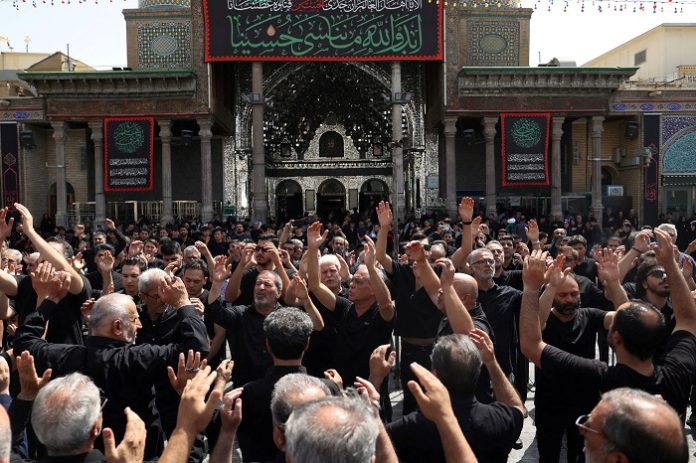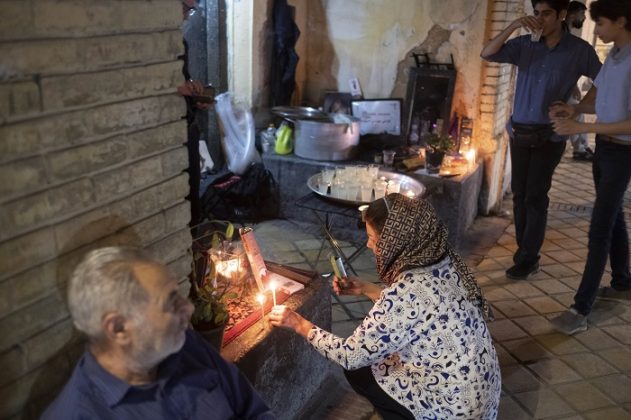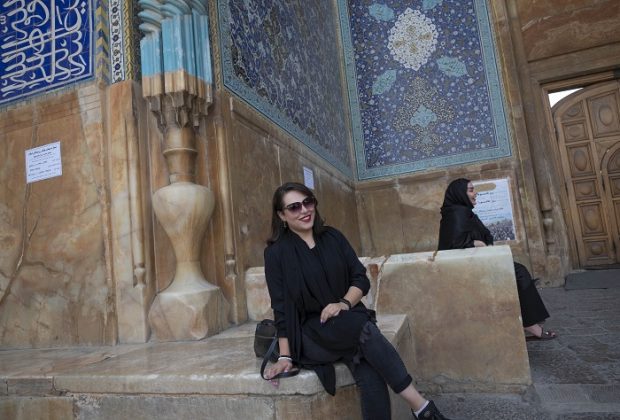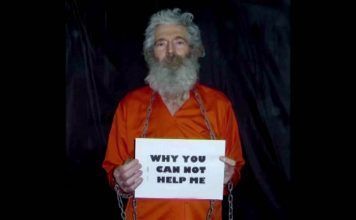
Religious processions held across Iran during the Holy month of Muharram to mourn the martyrdom of Shia’s third Imam Hussain (626 AD-680 AD) — the grandson of the Prophet Mohammad – were visibly different from previous years. Many lamentation ceremonies involved groups of self-flagellating men who were chanting anti-government slogans.
This was a significant development given that the processions came right before the anniversary of the nationwide revolt sparked by the death of 22-year-old Mahsa (Zhina) Amini while in the custody of the Morality Police in Tehran on Sept. 16, 2022.
During the holy processions, several maddahs (Koranic reciters and ceremonial singers delivering eulogies at Shia religious ceremonies) criticized the leader of the Islamic Republic in no uncertain terms and questioned the regime’s legitimacy.
[aesop_image img=”https://kayhanlife.com/wp-content/uploads/2023/08/2023-07-27T113128Z_1244387449_RC2BB2A53EJA_RTRMADP_3_IRAN-RELIGION.jpg” panorama=”off” credit=”Iranian Shi’ite Muslims take part in a mourning ritual ahead of Ashura, the holiest day on the Shi’ite Muslim calendar in Tehran, Iran July 26, 2023. REUTERS./” align=”center” lightbox=”on” captionsrc=”custom” captionposition=”left” revealfx=”off” overlay_revealfx=”off”]
Large numbers of young people also used new civil disobedience tactics to challenge the regime’s ideological principles. Unknown persons reportedly set fire to several religious institutions. State officials, especially clerics with various senior posts, have issued warnings about the situation.
[aesop_image img=”https://kayhanlife.com/wp-content/uploads/2023/08/2023-07-28T000000Z_740347980_MT1NURPHO000EX619K_RTRMADP_3_RELIGION-ASHURA-IRAN.jpg” panorama=”off” credit=”Iranian children playing water at a pool in front of a portrait of Ali Khamenei, at the Naghsh e Jahan square on Ashura on the tenth day of the Muslim holy month of Moharram in the city of Isfahan, 450 km (280 miles) south of Tehran, July 28, 2023. REUTERS./” align=”center” lightbox=”on” captionsrc=”custom” captionposition=”left” revealfx=”off” overlay_revealfx=”off”]
Muharram coincided with two significant events this year: the burning of a copy of the Koran in Sweden and the publication of video clips exposing the sexual perversions of two state officials.
The Islamic Republic’s propaganda machine tried to tie this year’s Muharram religious ceremonies with a lackluster Basij (volunteer militia) gathering to protest the burning of a copy of the Koran in Sweden. It was a failed attempt to prove that the regime had the people’s support.
On June 29, a former Popular Mobilization Forces (PMF) member burned a copy of the Koran in Stockholm. However, Iran’s leader Ali Khamenei did not comment on the incident until the start of Muharram on July 22.
Ayatollah Khamenei Demands ‘Most Severe Punishment’ for Those Who Burn Koran
The PMF — also known as the People’s Mobilization Committee (PMC) and the Popular Mobilization Units (PMU) — is an Iraqi state-sponsored umbrella organization comprising some 40 militias that are mostly Shia Muslim groups but also include Sunni Muslim, Christian, and Yazidi groups.
Tehran University to Admit Members of Iraqi Militia Group As Students
Some people argue that the regime took a massive hit in the month of Muharram after two videos were published on social media. One showed the director of the northern province of Gilan’s Office for the Islamic Guidance having sex with a young male, and the other showed a member of the Anzali City Council, in Gilan Province, smoking opium and pleasuring himself.
[aesop_image img=”https://kayhanlife.com/wp-content/uploads/2023/08/moharram1402.jpg” panorama=”off” credit=”KL./Ahmad Barakizadeh” align=”center” lightbox=”on” captionsrc=”custom” captionposition=”left” revealfx=”off” overlay_revealfx=”off”]
Both officials are well-known heyaatis (members of a religious committee, board, or group), and footage and photographs published on the Instagram channel and by the media outlets showed them attending religious mourning ceremonies.
A heyaat (committee, board, group) consists of officials and reciters who attend solemn religious and lamentation ceremonies, some claiming to belong to Ahl-e Beyt (Ahl al-Bayt), meaning to be descendants of the Prophet Mohammad.
The two video clips exposed rampant corruption within the system, particularly among the heyaatis, and discredited the regime and the sacred principles it relies on to justify its legitimacy.
A maddah (reciter) of the “Shah Hussain Gooyan” heyaat, located in the Javadiyeh neighborhood of southern Tehran, insisted that the heyaat was not a state-sponsored group and did not belong to any institution or organization, adding: “We are gathered here only for Imam Hussain.”
He also eulogized the young people who were killed since the start of the protests last September, and spoke of their grieving mothers and families who were prevented from holding funerals for their loved ones.
[aesop_image img=”https://kayhanlife.com/wp-content/uploads/2023/08/2023-07-26T000000Z_826103662_MT1NURPHO000MLED55_RTRMADP_3_IRAN-RELIGION.jpg” panorama=”off” credit=”An Iranian woman takes photographs with her cell phone while attending for watching a religious carnival marking Ashura on day eight of Muslim holy month of Moharram in Sede, near of the city of Isfahan, 495 km (309 miles) south of Tehran, July 27, 2023. REUTERS./” align=”center” lightbox=”on” captionsrc=”custom” captionposition=”left” revealfx=”off” overlay_revealfx=”off”]
[aesop_image img=”https://kayhanlife.com/wp-content/uploads/2023/08/2023-07-28T000000Z_150432770_MT1NURPHO000EX5L0B_RTRMADP_3_RELIGION-ASHURA-IRAN.jpg” panorama=”off” credit=”Iranian women walk along the Naghsh e Jahan square on Ashura on the tenth day of the Muslim holy month of Moharram in the city of Isfahan, 450 km (280 miles) south of Tehran, July 28, 2023. REUTERS./” align=”center” lightbox=”on” captionsrc=”custom” captionposition=”left” revealfx=”off” overlay_revealfx=”off”]
Several reciters said: “It is not our business if someone is here wearing no hijab.”
Gholam Kuwaitipour, a reciter and a performer of epic and religious songs, recently released his protest song Rais (meaning ‘the boss.’)
Kuwaitipour has been a vocal critic of the regime for the past few years. Some argue that the song was inspired by the anti-government movement and addressed Ali Khamenei directly, particularly the passage: “Stupid senior officials of the country, haji, they are brutalizing young people, and violating people’s honor mercilessly.”
Commenting on Kuwaitipour’s song, the Iranian writer and researcher Massoud Noghrekar said: “Reciters who are members of Ahl-e Beyt and Al-e Aba and the infallible and pure family are outraged.”
Al-e Aba, also known as Ahl al-Kisa or Ahl al-Aba, refers to Prophet Mohammad, his daughter Fatima, his cousin and son-in-law Ali, and his two grandsons Hassan and Hussain. The infallible and pure family refers to the family of Prophet Mohammad.
Noghrekar believes that although several reciters had previously warned presidents and state officials about “recalling tragedies and battle cries,” they had never addressed Khamenei and the entire system directly.
A reciter and mourners in “Be’ssat” heyaat in Yazd, the capital of the central province of Yazd, sang protest songs by Shahabuddin Mousavi (born 1971-) and ballads by Aref Ghazvini (1882-1934).
Reciters at the ceremony sang Aref Ghazvini’s ballad: “Tulips grow from the blood of the country’s youths, and cypresses bend in awe of their towering heights [not an official English translation.].”
During a Chalab Zani ceremony — in which religious mourners move in a circle while slapping their chest — in Dezful, in the southwestern province of Khuzestan, reciter Esmael Nasrollahi said in his lamentation: “Oh nation do you know how miserable I am? Their only concern is the hijab. They have stolen so much from the public fund.”
Speaking against oppression and corruption during his lamentation, the reciter of a self-flagellating (with chain) group in Kiyanshahr, in the southeastern province of Kerman, said: “Corrupt oppressors have misappropriated this land’s wealth and erected buildings for themselves while the unfortunate public suffers humiliating indignities.”
During this year’s Muharram, a large segment of the population challenged the Islamic regime’s distorted versions of religious beliefs, used to control people in the past 44 years.
Ali Karimi, the former captain of the Iranian national football team, posted footage showing Basijis and security forces brutalizing street protesters last year, with an overlaid soundtrack of Muharram lamentation.
“What we heard about Yazid, we saw from lackeys of the akhundi (clerical) regime,” the caption to the video clip by Mr. Karimi said.
Yazid ibn Mu’awiya ibn Abi Sufyan (Yazid I), the second Umayyad Caliph (680 AD-683 AD), and his massive army confronted Shia’s third Imam Hussain and his small band of supporters in Karbala, in modern-day Iraq. Hussain and most of his family were killed in the Battle of Karbala on Oct. 10, 680 AD (Muharram 10, 61 Islamic lunar calendar, known as Hijri).
Security forces arrested two young men who allegedly set fire to a “Nakhle Azadari” (mourning palm) belonging to the “Kushk” heyaat in Yazd Province.
Mourning palm, a massive and very heavy wooden ceremonial casket covered with a black and green shroud, symbolizing the martyrdom of Imam Hussain, is carried by a procession of mourners during the month of Muharram.
The ceremonial “Kettle and Alam” (pole and banner) — usually decorated with red, green, and black fabric — carried by mourners of “Al Ansar al-Hussain” heyaat during Muharram in Isfahan’s Kashani Street, the capital of the central province of Isfahan, were set on fire. The place is a hangout for the local Basijis.
The semi-official Fars news agency published a video on July 24 showing the procession poles and banners on fire.
“Unknown persons set fire to heyaat’s pole, angering Imam Hussain mourners,” Fars said. “People have urged the officials to identify the culprits and deal with them decisively.”
Young Iranians, especially girls, have expressed their opposition to the regime by dancing to the mourning recitations and songs. Although dancing to religious themes and lamentations is nothing new, it was much more extensive this year.
Opposition groups argue that the dancers aim to defy a regime that has violated people’s civil and human rights in the name of religion.
Speaking at Zanjan “Zainabiyeh Mourners Heyaat,” the capital of the northwest province of Zanjan, on July 26, Hojatoleslam Mohammad Mosaddegh, the first deputy head of the Judiciary warned that “Enemy’s [war] room works round the clock to undermine our religious convictions and the spirit of Ashura [10th of Muharram, marking the day Imam Hussain was killed].”
Several girls wearing relaxed hijabs walked to mourning processions and took selfies of themselves while making victory signs with their hands.
Sheikh Hussain Ansarian, a famous Koranic reciter, condemned the move and urged young Iranians, “If you want to sin on the 10th of Muharram, then stay home instead. The 10th of Muharram is not an occasion for removing hijab and eating haram [forbidden] food.”
Several reciters closely linked to the state warned that “the enemy is using various methods to weaken young people’s faith.”
Speaking on the occasion of Tasua (9th day of Muharram), July 27, at the Presidential Institution Salman Farsi Mosque in Tehran, Iranian President Ebrahim Raisi, said: “The Islamic Revolution’s doctrine is the continuation and extension of Ashura and Imam Hussain’s school of thought.”
“A new world order is shaping by the grace of pure blood of Islamic martyrs,” Raisi declared.
Ayatollah Seyyed Hashem Hosseini-Bushehri, a member of the Assembly of Experts, told his congregation on the same night that “some people are trying to replace morality with immorality in society.”
The reciter at “Ali Khamenei Beyt” hosayniya (a congregation hall for Twelver Shia Muslim commemoration ceremonies) said that Iran was “indebted to Imam and the martyrs.”
The reciter consoled the weeping Khamenei by assuring him, “I will stand by my leader to the end. I will give my life to my country. Thank God, I am the defender of the shrine.”
SADAS
The reciter echoed what was in the will of the former commander of the Islamic Revolutionary Guards Corps Qods Force (IRGC-QF), Lieutenant-General Ghasem Soleimani, who was killed in a U.S. drone attack on Baghdad International Airport on Jan. 3, 2020.
“Iran is the headquarters of Hussain ibn Ali today,” Soleimani’s will said. “Iran is a shrine, which, if it continues to exist, will ensure the survival of all other shrines. If the enemy destroys this shrine, no other shrine will survive.”
Although reciters in religious groups had criticized the state in the past, it was always within the context of insider and factional disputes. However, this year’s Muharram has opened a new chapter in open criticism of the regime, which is a significant development, given that Iranian intelligence and security agencies directly or indirectly monitor the activities of all religious groups. The senior officials of these groups are members of the IRGC or the Basij or have the support of those forces.
Forces that brutalized the public were trained at religious establishments before joining their neighborhood’s Basij forces. Religious reciters and their apprentices, closely linked to the state, exercise influence on the Basij bases. They are the red cells of the regime.
Some religious groups, with their permanent reciters and financial backers, are linked to the city halls and the IRGC. Some circles within the city halls and the IRGC have offices that religious groups use for meeting and conspiring.
Leaders of a heyaat and their families gain more significant influence when their religious organization prospers. For instance, these religious groups can mediate a dispute between a contractor and a district mayor. The groups can also help individuals to bypass building regulations to get a building permit.
The Islamic Republic had its finger on the pulse of religious groups long before the 1979 Islamic Revolution. The religious groups (boards, committees) facilitated street protests against the ruling monarchy during the Muharram of 1978 and 1979 in Tehran’s Bazar.
Following the Islamic Revolution, religious groups’ primary missions included:
-
Recruiting for the Iran-Iraq War (1980-88),
-
Deploying forces to Syria and Iraq towards the end of 2001 under the banner of the “defenders of the holy shrines” (armed groups defending Shia shrines in Iraq and Syria),
-
Strengthening neighborhood security forces to crush anti-government protests,
-
Invading people’s private lives, and being on the frontline of defending the regime’s principles at the core of the society,
-
Operating as a political and ideological headquarters for the power mafia to collect votes or conduct disruptive actions.
Since the establishment of the Islamic Republic, politicians, and political parties with more significant support among religious groups have exerted greater influence within the regime. Gangs of hoodlums and thugs linked to these religious groups also carry political clout within the ruling system.
However, the Islamic Republic system faces a massive challenge with opposition voices inside religious groups.
A segment of the state security apparatus will collapse if the Islamic Republic loses the pulse of these religious groups.
EXCLUSIVE: Iran’s Gang Leaders Are Refusing to Help IRGC Crush Protests
ANALYSIS – Basij Force: Specialists in Cracking Down on Dissent














